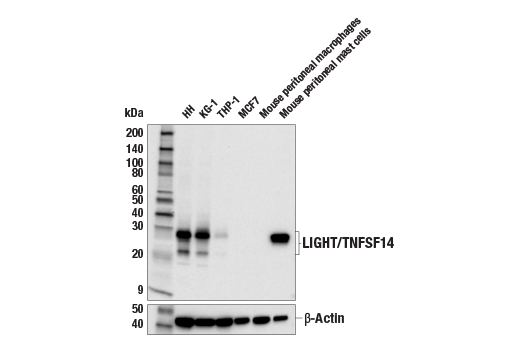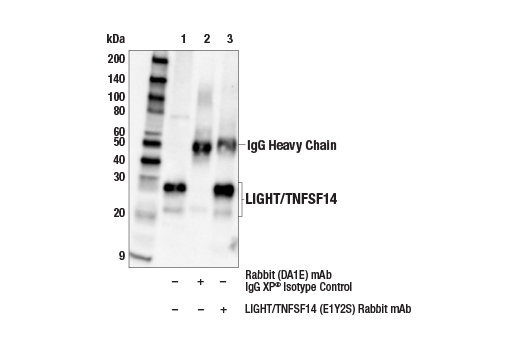WB, IP
H M
Endogenous
28
Rabbit IgG
#O43557
8740
Product Information
Product Usage Information
| Application | Dilution |
|---|---|
| Western Blotting | 1:1000 |
| Immunoprecipitation | 1:100 |
Storage
Specificity / Sensitivity
Species Reactivity:
Human, Mouse
Source / Purification
Monoclonal antibody is produced by immunizing animals with recombinant protein specific to the extracellular domain of human LIGHT/TNFSF14 protein.
Background
Tumor necrosis factor superfamily member 14 (TNFSF14), also known as CD258 and LIGHT, is a cell surface type II transmembrane protein that is expressed as a homotrimer (1). The extracellular region can be cleaved to generate a soluble cytokine (2). TNFSF14 is a ligand for the receptors herpesvirus entry mediator (HVEM) and lymphotoxin receptor (LTR) (1). TNFSF14 is expressed on activated NK cells, activated T cells, activated monocytes, immature DCs, and mast cells (1,3,4). TNFSF14 interactions with HVEM induce potent co-stimulatory signaling in T cells and trigger NK cells to produce IFN-γ via NF-κB RelA/p50 pathway signaling (5,6). TNFRSF14 produced by tumor-sensing NK cells aids in DC maturation, enabling de novo anti-tumor adaptive immune responses (7). TNFSF14-HVEM interactions are considered the main drivers of anti-tumor immune responses, whereas TNFSF14-LTR interactions have been characterized as maintaining the infrastructure that supports the anti-tumor response via lymphoid development and cancer cells’ susceptibility to the immune response (8,9). TNFSF14 induces the normalization of tumor vasculature, sensitizes tumor cells to IFN-γ-mediated apoptosis, and results in a more inflamed tumor microenvironment (TME) (6,8,10,11). Due to its effects on the TME and anti-tumor immune cell responses, TNFSF14 is being investigated as a target for immunotherapeutic intervention in cancer (9). TNFSF14 has also been implicated in the development and pathogenesis of inflammatory bowel disease and airway remodeling leading to asthma (12,13).
- Mauri, D.N. et al. (1998) Immunity 8, 21-30.
- Granger, S.W. et al. (2001) J Immunol 167, 5122-8.
- Wang, J. et al. (2001) J Clin Invest 108, 1771-80.
- Sibilano, R. et al. (2016) Nat Commun 7, 13696.
- Tamada, K. et al. (2000) Nat Med 6, 283-9.
- Fan, Z. et al. (2006) Blood 107, 1342-51.
- Holmes, T.D. et al. (2014) Proc Natl Acad Sci U S A 111, E5688-96.
- Lu, T.T. and Browning, J.L. (2014) Front Immunol 5, 47.
- Skeate, J.G. et al. (2020) Front Immunol 11, 922.
- Zhang, M. et al. (2003) Cancer Lett 195, 201-10.
- Kanodia, S. et al. (2010) Cancer Res 70, 3955-64.
- Cohavy, O. et al. (2004) J Immunol 173, 251-8.
- Doherty, T.A. et al. (2011) Nat Med 17, 596-603.
Species Reactivity
Species reactivity is determined by testing in at least one approved application (e.g., western blot).
Western Blot Buffer
IMPORTANT: For western blots, incubate membrane with diluted primary antibody in 5% w/v BSA, 1X TBS, 0.1% Tween® 20 at 4°C with gentle shaking, overnight.
Applications Key
WB: Western Blotting IP: Immunoprecipitation
Cross-Reactivity Key
H: human M: mouse R: rat Hm: hamster Mk: monkey Vir: virus Mi: mink C: chicken Dm: D. melanogaster X: Xenopus Z: zebrafish B: bovine Dg: dog Pg: pig Sc: S. cerevisiae Ce: C. elegans Hr: horse GP: Guinea Pig Rab: rabbit All: all species expected
Trademarks and Patents
使用に関する制限
法的な権限を与えられたCSTの担当者が署名した書面によって別途明示的に合意された場合を除き、 CST、その関連会社または代理店が提供する製品には以下の条件が適用されます。お客様が定める条件でここに定められた条件に含まれるものを超えるもの、 または、ここに定められた条件と異なるものは、法的な権限を与えられたCSTの担当者が別途書面にて受諾した場合を除き、拒絶され、 いかなる効力も効果も有しません。
研究専用 (For Research Use Only) またはこれに類似する表示がされた製品は、 いかなる目的についても FDA または外国もしくは国内のその他の規制機関により承認、認可または許可を受けていません。 お客様は製品を診断もしくは治療目的で使用してはならず、また、製品に表示された内容に違反する方法で使用してはなりません。 CST が販売または使用許諾する製品は、エンドユーザーであるお客様に対し、使途を研究および開発のみに限定して提供されるものです。 診断、予防もしくは治療目的で製品を使用することまたは製品を再販売 (単独であるか他の製品等の一部であるかを問いません) もしくはその他の商業的利用の目的で購入することについては、CST から別途許諾を得る必要があります。 お客様は以下の事項を遵守しなければなりません。(a) CST の製品 (単独であるか他の資材と一緒であるかを問いません) を販売、使用許諾、貸与、寄付もしくはその他の態様で第三者に譲渡したり使用させたりしてはなりません。また、商用の製品を製造するために CST の製品を使用してはなりません。(b) 複製、改変、リバースエンジニアリング、逆コンパイル、 分解または他の方法により製品の構造または技術を解明しようとしてはなりません。また、 CST の製品またはサービスと競合する製品またはサービスを開発する目的で CST の製品を使用してはなりません。(c) CST の製品の商標、商号、ロゴ、特許または著作権に関する通知または表示を除去したり改変したりしてはなりません。(d) CST の製品をCST 製品販売条件(CST’s Product Terms of Sale) および該当する書面のみに従って使用しなければなりません。(e) CST の製品に関連してお客様が使用する第三者の製品またはサービスに関する使用許諾条件、 サービス提供条件またはこれに類する合意事項を遵守しなければなりません。

